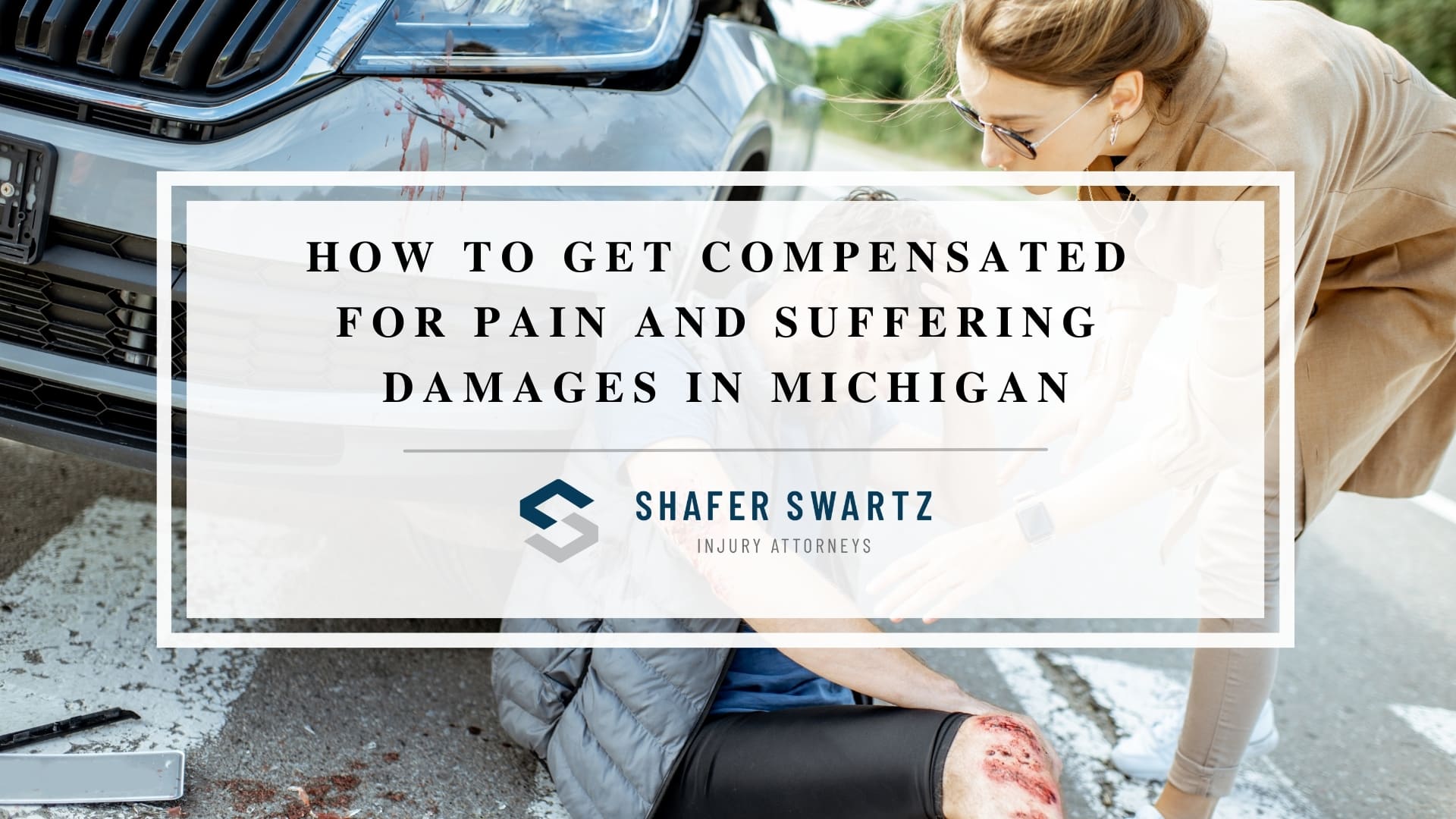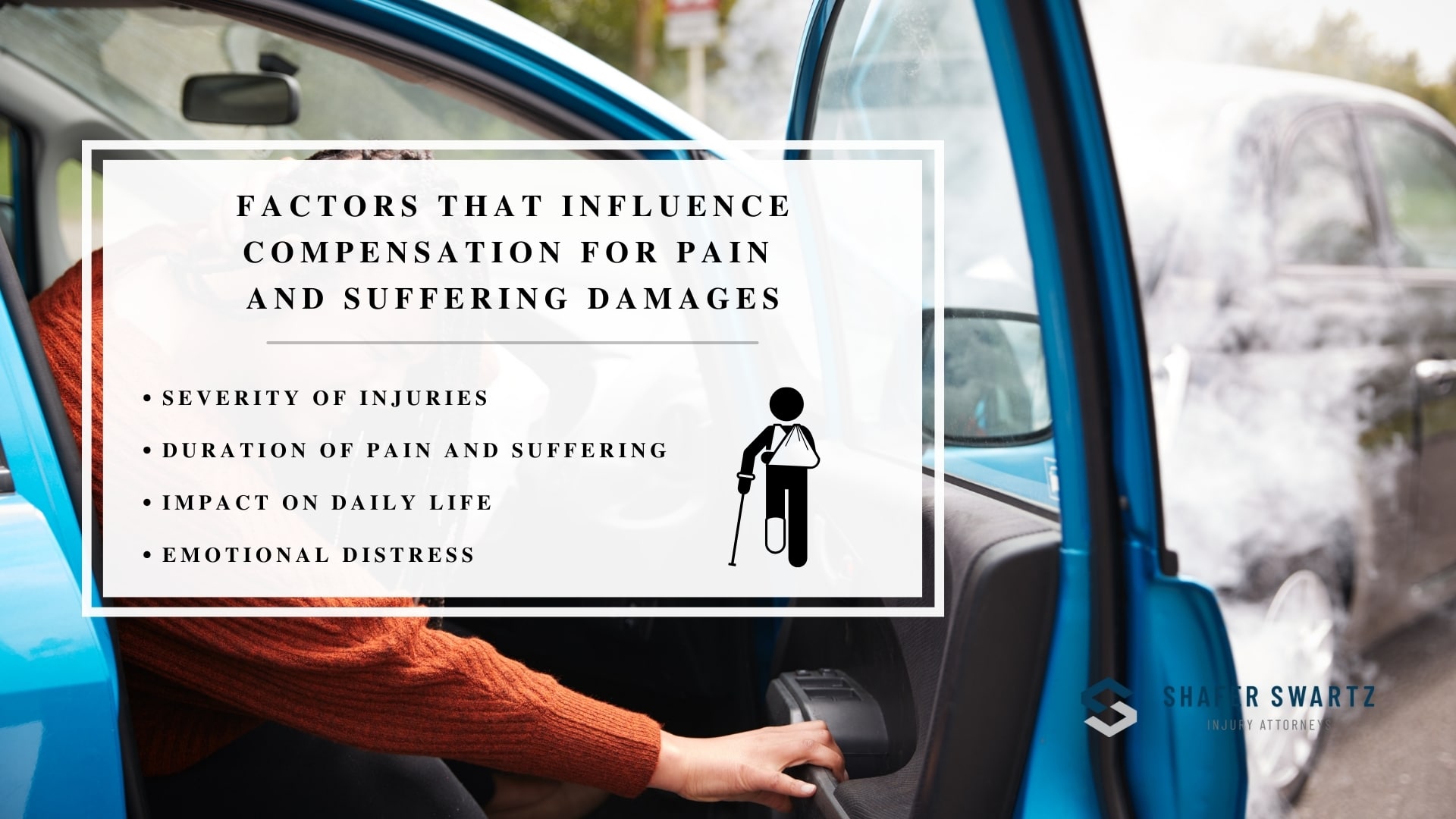Thanks to TV and Movies, people have misconceptions about suing for pain and suffering. Hollywood often suggests the idea that people suing for pain and suffering are “faking it” and that receiving a large financial settlement requires you to “put on an act”. In reality, that is not the case.
Michigan’s No-Fault Insurance System
First of all, Michigan is a “no-fault” state. This means that if you were in a car accident, you are entitled to compensation regardless of who was at fault. Here are examples of the compensation you’re entitled to:
-
- Medical Expenses
- Lost Wages
- Replacement Services
- Attendant Care Services
- Mileage Reimbursement
These are examples of “economic damages” or “out-of-pocket” expenses related to the accident. If you were injured in an auto accident, add the above items together to get a ballpark idea of your settlement amount for economic damages.
The only time a person is not entitled to compensation (no-fault benefits) is if the person seeking the benefits was the driver of the vehicle, owns the vehicle they were driving, and the vehicle was not insured at the time of the accident.
However, you can also sue for “noneconomic damages” which is commonly referred to as “pain and suffering.” For example, when a car accident caused by the negligence of another driver ends your career as a surgeon, you may be able to sue the insurance company of the other driver.
The threshold for “pain and suffering” is high. According to Michigan law, it’s serious impairment of body function, permanent and serious disfigurement, or wrongful death. Unlike what you’ve seen in movies or on TV, compensation for pain and suffering is no gimmick. As state law dictates, it involves serious impairment that is often permanent.
Exceptions to No-Fault
In Michigan, because your own automobile insurance company typically pays for your medical bills and wage loss, it is often the case that your claim against a negligent driver’s insurance company is only for “noneconomic” or “pain-and-suffering” damages and excess wage loss (wages lost due to an injury that exceeds the three-year maximum coverage for wages paid by the no-fault carrier, and/or wages that are lost more than three years after the accident).
The financial compensation you can reasonably ask for or expect a jury to award depends on several factors. These factors include, but are not limited to, the seriousness of your injuries, the amount and frequency of treatment you have received, whether you have missed any work, how fully you recover from your injuries, and the amount that insurance funds that are available to recover.
According to Michigan Law, an injured person (or their survivors) can sue if the injured person has suffered:
-
- Death
- Serious Impairment of Body Function
- Permanent Serious Disfigurement
What Does Serious Impairment of Body Function Mean
“Serious impairment of body function” means an impairment that satisfies all of the following requirements:
-
- It is objectively manifested, meaning it is observable or perceivable from actual symptoms or conditions by someone other than the injured person.
- It is an impairment of an important body function, which is a body function of great value, significance, or consequence to the injured person.
- It affects the injured person’s general ability to lead his or her normal life, meaning it has had an influence on some of the person’s capacity to live in his or her normal manner of living.
Although the length of time may be relevant, there is no time requirement for how long an impairment must last. This examination is inherently fact and circumstance specific to each injured person. It must be conducted on a case-by-case basis and requires a comparison of the injured person’s life before and after the incident.
Establishing Pain and Suffering Damages
Proving pain and suffering damages involves demonstrating the physical and emotional distress experienced as a direct result of the incident. Here’s how you can establish the extent of these damages:
-
- Seek Medical Attention. Timely medical care not only ensures your health and safety but also provides a crucial foundation of evidence for your claim. Medical records substantiate the nature and severity of your injuries, so be sure to document all damages incurred, no matter how minor they may seem initially.
- Gather Evidence. Collect as much evidence as possible to support your pain and suffering claim. This includes photographs of your injuries, the accident scene, and any property damage. Also, keep records of all medical treatments, therapies, medications, and any out-of-pocket expenses related to your injuries.
- Document Emotional Distress. Pain and suffering damages aren’t limited to physical injuries; they also encompass emotional distress. Keep a journal describing your emotional state, sleep disturbances, anxiety, or depression resulting from the accident.
- Obtain Expert Testimonies. Experts, such as medical professionals or therapists, can provide testimony about the extent of your injuries and the long-term impact on your life. Their professional opinions can carry significant weight in establishing the validity of your pain and suffering claim.
- Prove Impact on Daily Life. Describe how the injuries have affected your daily life and activities. If you can no longer participate in hobbies, sports, or social activities, provide specific examples. Also, detail any challenges faced in your professional life due to the injuries.
- Seek Legal Assistance. A local personal injury attorney can guide you through the legal process, help gather necessary evidence, and present a compelling case on your behalf. Attorneys are skilled in articulating your pain and suffering in a way that is persuasive to insurance companies or in a court of law.
How Much Can You Get for Pain and Suffering Lawsuits
Unlike economic damages, pain and suffering damages are intangible and don’t have a clear price tag. Several factors can influence the compensation awarded for these damages, which include:
-
- Severity of Injuries. The more severe your injuries, the higher the potential for pain and suffering compensation.
- Duration of Pain and Suffering. Longer recovery periods, especially with ongoing pain and limitations, usually lead to higher compensation.
- Impact on Daily Life. The inability to perform regular activities and hobbies can increase the compensation amount.
- Emotional Distress. Documented emotional distress can strengthen your case.
There’s no fixed formula for calculating pain and suffering compensation. Instead, these factors are weighed and considered together, making every case unique. In many cases, lawyers use the Per Diem and the Multiplier method to quantify the pain and suffering damages.
The Per Diem method involves assigning a daily rate, representing the value of your pain and suffering. The daily rate is then multiplied by the number of days you experienced pain and suffering due to the injuries sustained in the accident. For instance, if the determined daily rate is $200, and you suffered for 100 days, your pain and suffering compensation would be $20,000.
On the other hand, the Multiplier method is more common and slightly more complex, as it involves calculating your economic damages and then multiplying that sum by a specific multiplier, usually ranging from 1.5 to 5, depending on the factors mentioned. For example, if your economic damages amount to $50,000 and the chosen multiplier is 3, your pain and suffering compensation would be $150,000. The multiplier reflects the perceived extent of your pain and suffering; a higher multiplier is used for more severe or life-altering injuries.
The Role of Comparative Negligence Framework
Comparative negligence is a legal principle used in personal injury cases to determine the degree of fault of each party involved in an accident or injury. Under this system, the total compensation a plaintiff receives is adjusted based on their percentage of fault for the incident.
In Michigan, your personal injury claim is subject to the Comparative Negligence rule. Hence, even if you are partially at fault for the accident, you can still seek compensation, but the amount will be reduced by your percentage of fault. For example, if you are found to be 40% at fault, and your damages were initially valued at $100,000, you would only receive $60,000 (60% of the original amount).
However, under the Michigan Modified Comparative Negligence Framework, if you are found to be more than 50% at fault for the accident, you will not be able to recover non-economic damages, including pain and suffering. But you are still eligible to receive economic damages, such as medical expenses and lost wages.
Statute of Limitations
According to the Michigan civil statutes of limitations, you have three years from the date of the accident to file a lawsuit seeking compensation for pain and suffering damages. Courts are generally strict about adhering to these deadlines, and failure to file within the stipulated three-year window could lead to the dismissal of your claim.
We Make It Right – You Deserve Justice
Shafer Swartz PLC understands the physical and emotional toll of personal injuries, and we’re here to help you seek fair compensation for your pain and suffering. Our experienced personal injury lawyer can provide expert legal guidance, help you gather compelling evidence, and skillfully negotiate with insurance companies to ensure you receive the best possible outcome for your case. Contact us today at (231) 722-2444 or here, and let our team guide you toward the justice and compensation you rightfully deserve.


